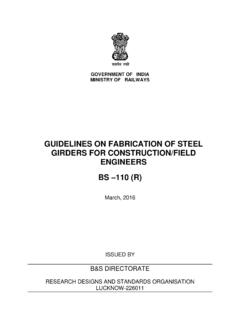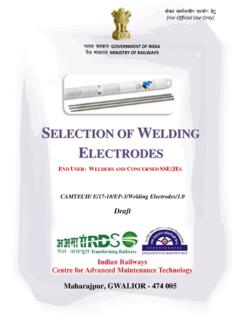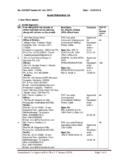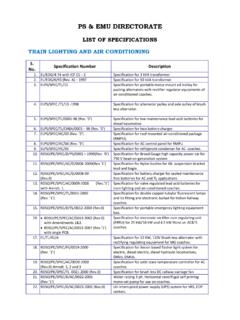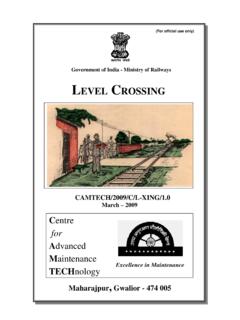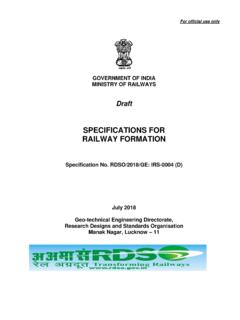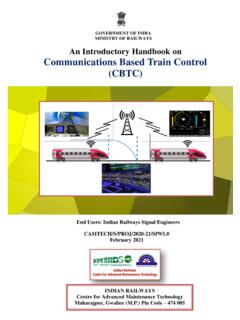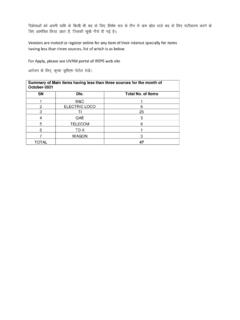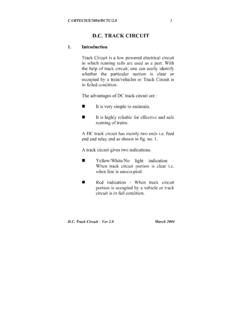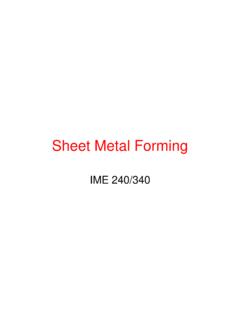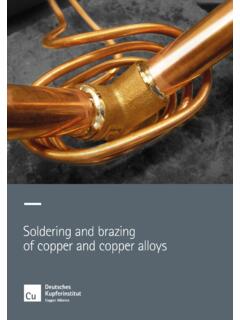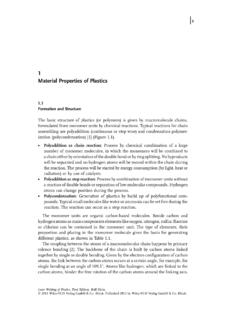Transcription of HANDBOOK ON WELDING TECHNIQUES - Indian Railways
1 Hkkjr ljdkj GOVERNMENT OF INDIA jsy ea=ky; MINISTRY OF Railways egkjktiqj, Xokfy;j & 474 005 Maharajpur, GWALIOR - 474 005 CAMTECH/ E/ 14-15/ WELDING / DRAFT dsoy dk;Zky;hu mi;ksx gsrq (For Official Use Only) HANDBOOK ON WELDING TECHNIQUES END USER: Newly Recruited/ Promoted Welders QUALITY POLICY To develop safe, modern and cost effective Railway Technology complying with Statutory and Regulatory requirements, through excellence in Research, Designs and Standards and Continual improvements in Quality Management System to cater to growing demand of passenger and freight traffic on the Railways . HANDBOOK ON WELDING TECHNIQUES CONTENTS Item No. Description Page No. Contents III 1. GENERAL DESCRIPTION 01 METAL JOINING METHODS 01 COMPARISON BETWEEN WELDING AND OTHER METAL JOINING METHODS 01 ADVANTAGES OF WELDING 02 DIFFERENT METHODS OF WELDING 02 Fusion WELDING without pressure 02 Pressure WELDING 02 Non-fusion WELDING 03 CLASSIFICATION OF WELDING PROCESSES ACCORDING TO HEAT 03 CODES FOR WELDING PROCESSES 04 APPLICATIONS OF VARIOUS WELDING PROCESSES 04 STATES OF MATTER 05 COMMON METALS AND ALLOYS 06 PROPERTIES OF METALS 06 Chemical properties 06 Physical properties 06 Mechanical Properties 07 Effect of WELDING heat on the properties of metals 08 EFFECT OF ATMOSPHERIC AIR ON WELDING 08 TYPES OF WELDS 09 Bead weld
2 09 Butt weld or groove weld 09 Fillet welds 10 Plug or slot welds 10 2. ELECTRIC WELDING PROCESSES 11 ELECTRIC WELDING 11 TYPES OF ELECTRIC WELDING 11 ELECTRIC ARC WELDING 12 Metallic arc WELDING 12 Carbon arc WELDING 12 Atomic hydrogen arc WELDING 12 Tungsten inert gas arc WELDING (TIG) 13 Gas metal arc WELDING (GMAW) or Metal inert gas arc WELDING (MIG) 13 Submerged arc WELDING 14 Electro-slag WELDING 14 Plasma arc WELDING 14 Item No. Description Page No. SHIELDED METAL ARC WELDING (SMAW) 15 Salient Features 15 Advantages 15 Limitations 16 Applications 16 ARC LENGTH 16 Medium, normal arc 16 Long arc 17 Short arc 17 SAFETY IN MANUAL METAL ARC WELDING 17 Safety apparels 18 WELDING hand screens and helmet 19 ARC WELDING ACCESSORIES 20 Electrode-holder 20 Earth Clamp 20 WELDING cables/ leads 20 MATERIAL PREPARATION METHOD 21 Cutting 21 Cleaning 21 OPEN CIRCUIT VOLTAGE AND ARC VOLTAGE 22 POLARITY IN DC ARC WELDING 22 Importance of polarity in WELDING 22 Indication of wrong polarity 23 MILD STEEL WELDING ELECTRODES 23 Electrode sizes 23 Functions of an electrode in shielded metal arc WELDING (SMAW)
3 24 Identification of Electrodes 24 Types of electrodes 25 FLUX COATED ELECTRODES 26 Merits of Flux coated electrodes 26 Coating factor 27 Types of material used in flux coated electrode 27 Electrode coding 27 WELDING MACHINES (POWER SOURCES) 27 WELDING transformer 27 WELDING Rectifiers 28 WELDING Generator 28 WELDING inverters 29 3. OXY-ACETYLENE GAS WELDING 30 GAS WELDING 30 OXY-ACETYLENE WELDING 30 Acetylene 30 Oxygen 30 OXY-ACETYLENE WELDING EQUIPMENT AND ACCESSORIES 31 Oxygen gas cylinders 31 Dissolved acetylene cylinders 31 Item No. Description Page No. Oxygen pressure regulator 31 Acetylene regulator 31 Rubber hose pipes and connections 32 Hose protectors 32 Blowpipe and nozzle 32 SAFETY PRECAUTIONS IN HANDLING OXY-ACETYLENE GAS WELDING PLANT 33 General safety precautions 33 Safety concerning gas cylinders 34 Safety of rubber hose-pipes 35 TROUBLE WITH BLOW PIPE & CYLINDERS 36 Backfire 36 Flashback 36 Cylinder catches fire 37 TYPES OF OXY-ACETYLENE FLAMES 37 Neutral flame 37 Oxidizing flame 38 Carburizing flame 38 Chemistry of oxy-acetylene flame 38 FILLER RODS FOR GAS WELDING 39 Filler rod and its necessity 39 Sizes as per IS.
4 1278-1972 40 Types of filler rods 40 Selection of the filler rod 40 Care and maintenance 41 Different filler metals and fluxes for gas WELDING 42 WELDING TECHNIQUES OF OXY-ACETYLENE WELDING 44 Leftward WELDING Technique 44 Rightward WELDING technique 46 WELDING OF LOW CARBON STEEL AND MEDIUM CARBON STEEL 45 Low carbon steels 47 Medium carbon steel 47 High carbon steels 47 4. OXY-ACETYLENE GAS CUTTING 48 INTRODUCTION 48 PRINCIPLE OF GAS CUTTING 48 Cutting Operation 48 Application of Cutting Torch 49 OXY-ACETYLENE CUTTING EQUIPMENT 49 Cutting Torch 49 Difference between Cutting Torch (Blow Pipe) & WELDING Blow Pipe 49 Care & Maintenance 50 Problem with Cutting Torch 50 Item No.
5 Description Page No. 5. FAULTS AND DEFECTS IN GAS WELDING 51 WELD DEFECTS & TYPES 51 External Defects 51 Internal Defects 51 TYPES OF FAULTS IN GAS WELDING 52 GAS WELD DEFECTS POSSIBLE CAUSES AND REMEDIES 55 ARC WELD DEFECTS POSSIBLE CAUSES AND REMEDIES 57 ANNEXURE - I CLASSIFICATION OF ELECTRODE 63 ANNEXURE II USAGE & STORAGE OF ELECTRODES 66 ANNEXURE III GUNA BAR TECHNIQUE FOR REPAIRING OF CRACKED CAST STEEL BOGIE FRAMES 68 REFERENCES 70 CAMTECH/E/14-15/ HANDBOOK on WELDING TECHNIQUES Draft 1 CHAPTER 1 GENERAL DESCRIPTION METAL JOINING METHODS The art of joining metals is about 3000 years old. The origin of WELDING is probably to be traced to the shaping of metals.
6 In industry every worker is working for changing the shape of metals by different methods and machines. WELDING is a metal joining method. The following methods are used for joining metals: (i) Soldering This joint is made on thin metals using solder as a joining medium. The melting point of solder is less than the metals to be joined. The joint can be opened by heating upto the solder melting temperature (below 400 C). (ii) Brazing The joint is similar to soldering but has more strength. The joining medium used is brass, which has a higher melting temperature than solder. The joint can also be opened by heating upto the melting point of brass (850-950 C). (iii) WELDING A metal joining method in which the joining edges are heated and fused together with or without filler metal to form a permanent (homogeneous) bond is known as WELDING .
7 Or in other words, WELDING is a process of joining two or more pieces of the same or dissimilar materials to achieve complete coalescence. This is the only method of developing monolithic structures and it is often accomplished by the use of heat and/or pressure. COMPARISON BETWEEN WELDING AND OTHER METAL JOINING METHODS Joining methods like riveting, assembling with bolt, seaming, soldering and brazing all result in temporary joints. WELDING is the only method to join metals permanently. The temporary joints can be separated if: - the head of the rivet is cut - nut of the bolt is unscrewed - hook of the seam is opened - more heat is given than that required for soldering and brazing. Welded joints cannot be separated like soldering and brazing because it is made homogeneous by heating and fusing the joining edges together.
8 CAMTECH/E/14-15/ Draft HANDBOOK on WELDING TECHNIQUES 2 ADVANTAGES OF WELDING WELDING is superior to other metal joining methods because it: - is a permanent pressure tight joint - occupies less space - gives more economy of material - has less weight - withstands high temperature and pressure equal to joined material - can be done quickly - gives no colour change to joints. It is the strongest joint and any type of metal of any thickness can be joined. DIFFERENT METHODS OF WELDING WELDING is a method of joining metals permanently. It is an ancient method, about 1500 years old. The method used in ancient days was forge or blacksmith WELDING . One of the methods of classifying welded joints is the method used to effect the joint between metal pieces. Accordingly the methods are: - fusion method without pressure/ with pressure - non-fusion method Fusion WELDING without pressure A method of WELDING in which similar and dissimilar metals are joined together by melting and fusion their joining edges with or without the addition of filler metal but without the application of any kind of pressure is known as fusion WELDING without pressure.
9 The joint made is permanent. The common heating sources are: - arc WELDING - gas WELDING - chemical reaction (thermit WELDING ) Pressure WELDING This is a method of WELDING in which similar metals are joined together by heating them to plastic or partially molten state and then joined by pressing or hammering without the use of filler metal. This is fusion method of joining with pressure. Heat source may be blacksmith forge (forge WELDING ) or electric resistance (resistance WELDING ) or friction. CAMTECH/E/14-15/ HANDBOOK on WELDING TECHNIQUES Draft 3 Non-fusion WELDING This is a method in which similar or dissimilar metals are joined together without melting the edges of the base metal by using a low melting point filler rod but without the application of pressure.
10 CLASSIFICATION OF WELDING PROCESSES ACCORDING TO HEAT SOURCE According to the sources of heat, WELDING processes can be broadly classified as: - Electric WELDING processes (heat source is electricity) - Gas WELDING processes (heat source is gas flame) - Other WELDING processes (heat source is neither electricity nor gas flame) Electric WELDING processes can be classified as: - Electric arc WELDING - Electric resistance WELDING - laser WELDING - Electron beam WELDING - Induction WELDING Electric arc WELDING can be further classified as: - Metallic arc WELDING - Carbon arc WELDING - Atomic hydrogen arc WELDING - Inert gas arc WELDING / TIG WELDING - CO2 gas arc WELDING - Flux cored arc WELDING - Submerged arc WELDING - Electro-slag WELDING - Plasma arc WELDING Electric resistance WELDING can be further classified as: - Spot WELDING - Seam WELDING - Butt WELDING - Flash butt WELDING - Projection WELDING Gas WELDING processes can be classified as: - Oxy-acetylene gas WELDING - Oxy-hydrogen gas WELDING - Oxy-coal gas WELDING - Oxy-liquefied petroleum gas WELDING - Air acetylene gas WELDING CAMTECH/E/14-15/ Draft HANDBOOK on WELDING TECHNIQUES 4 The other WELDING processes are.
